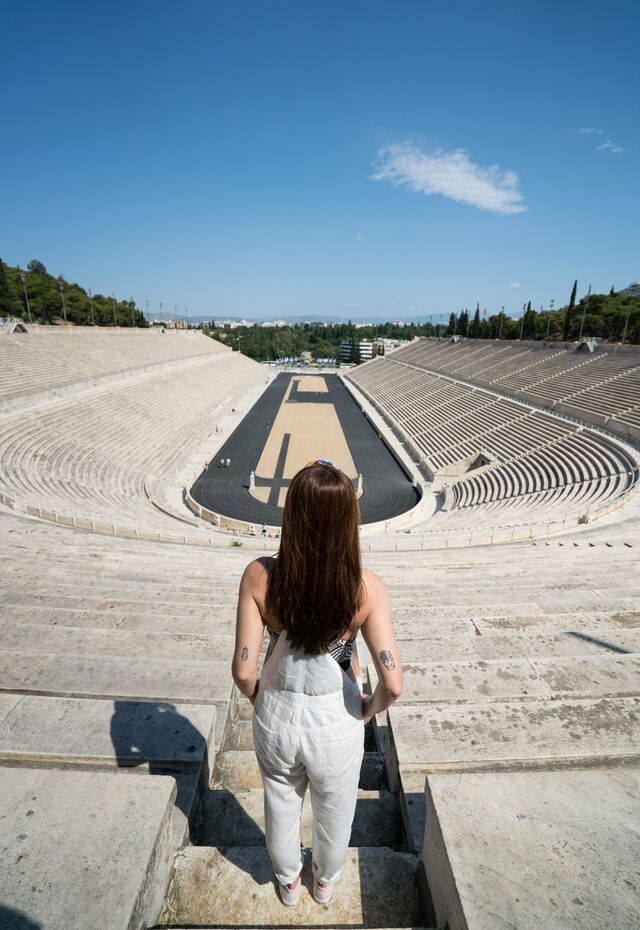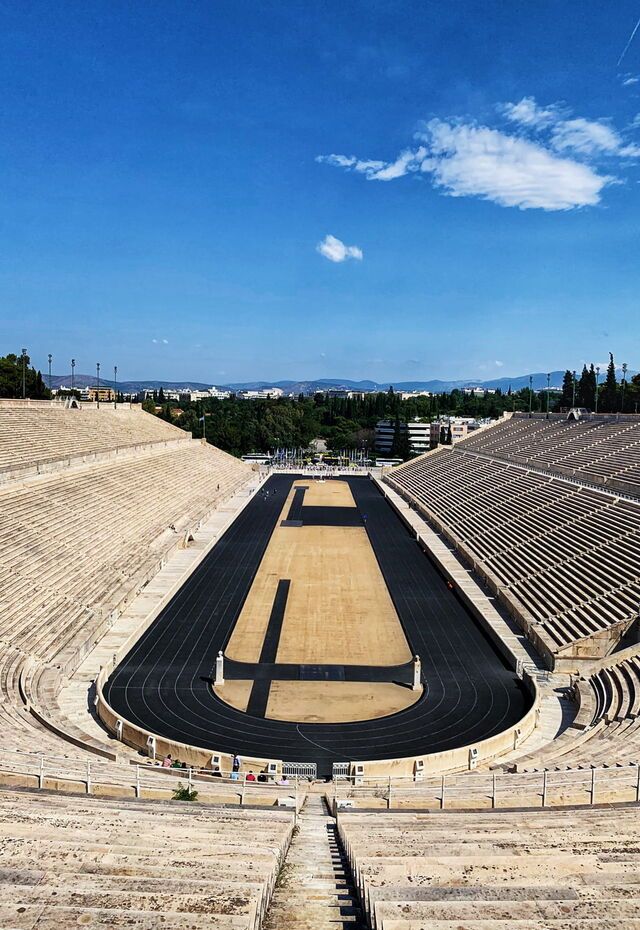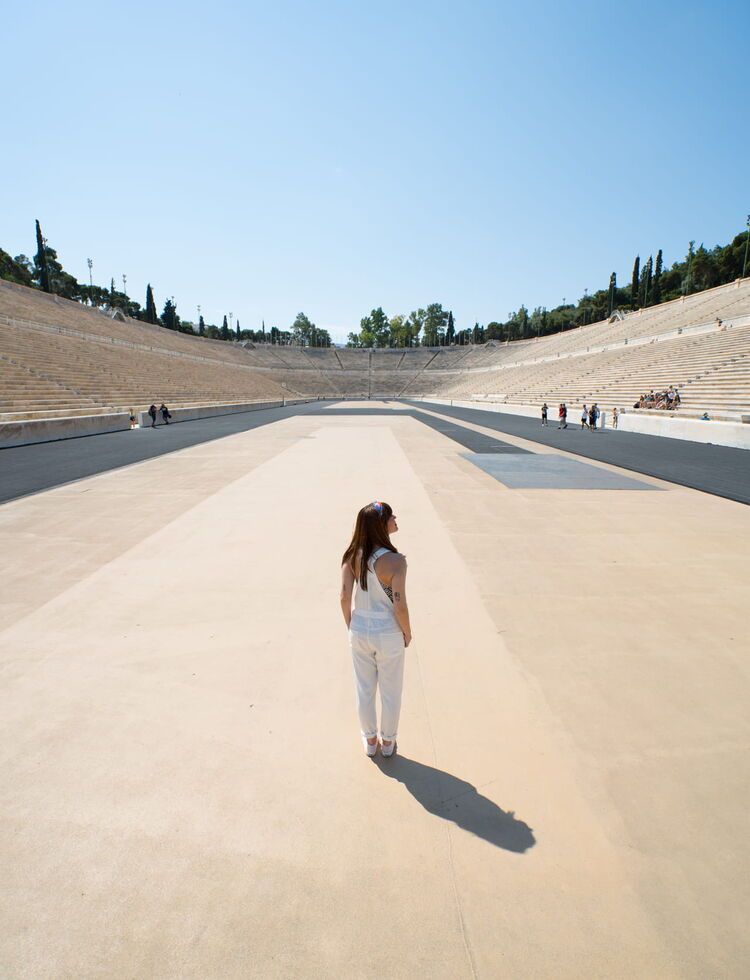A tour of the Panathenaic Stadium in Athens


OVERVIEW
Standing in front of the horseshoe-shaped Panathenaic Stadium in Athens, you can easily imagine the 80,000 spectators at the opening ceremony of the first modern Olympics in 1896, cheering the establishment of the ideals of excellence, friendship and respect through sport. What might be harder to imagine are the 50,000 spectators in the mid-2nd century AD in what was (in shape at least) a similar stadium, revelling in the gladiatorial battles and animal baiting during Athens’ Roman occupation..
Both scenes are part of the unique history of this Athens landmark, although the stadium’s Olympic legacy is its defining characteristic and its main reason for visiting.
Its history goes back to 330 BC when the Athenian statesman Lykourgos built the original limestone stadium on the site of a racecourse to stage the Panathenaic Games (a religious and athletic festival celebrated every four years in honour of the goddess Athena).
It was rebuilt by Athenian benefactor Herodes Atticus by 144 AD (when it was given a 50,000-seat capacity and resumed its place as a major Athens monument) but fell out of use by the 4th century AD, becoming derelict until it was chosen as the host venue for the first modern Olympics. Evangelos Zappas provided the vision and George Averoff (an Egypt-based Greek businessman from Metsovo) the money … and the result was (what is still) the only all-marble stadium in the world. Its other name (Kallimarmaro) means ‘beautiful marble’.
The real beauty of the Panathenaic Stadium, however, is that it is still part of the daily lives of Athenians, with the surrounding woodland and even the track used as a jogging venue. It’s the finishing line for the annual Athens Marathon and, every four years, holds the Olympic Flame handover ceremony. During the 2004 Athens Olympics, it once again became an Olympic venue, hosting the archery competition.
For the price of admission, you’ll line up on the running track like those first modern Olympians, pose for a photo on the winner’s podium, visit the on-site museum and walk through the Vaulted Passage and diodos, the underground passage used by ancient athletes entering the stadium.
GET PLANNING
Where is the Panathenaic Stadium in Athens?
- The Panathenaic Stadium is found below Athens’ National Garden (near the Zappeion Exhibition Hall) on Vasileos Konstantinou Ave, at the start of the neighbourhood of Pangrati. It is a 1.2km walk (15 mins) from Syntagma Square metro station (blue and red line).
How do you get to the centre of Athens from the airport or port?
- From Athens International Airport, you can catch a taxi (around €40 during the day), bus (Χ95) or the metro (blue line to Syntagma) directly into the centre. Alternatively, you can hire a car at the airport.
- From the port of Piraeus, you can catch a taxi (around €30 during the day), bus (Χ80 or 040 to Syntagma from Gate E12) or the metro (blue line to Syntagma) directly into the centre. Depending on which port gate you arrive at, it is a 15-20-minute walk to the metro station.
When is the best time to visit the Panathenaic Stadium in Athens?
- The Panathenaic Stadium is open all year round (closed on some national holidays).
- Because of the marble, the temperature in the stadium during summer can be very high so it is best to visit in the morning or late afternoon.
What are the opening times of the Panathenaic Stadium and how much are tickets?
- March-October: 08:00-19:00 (last ticket sold at 19:00)
- November-February: 08:00-17:00 (last ticket sold at 17:00)
- Tickets cost €5 (€2.50 reduced)
- More information on opening hours & tickets here
- Autumn
- Spring
- Summer
- Winter
- Visiting the stadium and museum takes 1-2 hours.
- More information on guided tours can be found here.
- Included in your ticket is an audio guide (11 languages) and entry to the on-site museum, which includes a "Memories of the Olympic Games: Posters and Torches from 1896 till today” permanent exhibition.
- There is a gift shop selling Kallimarmaro-inspired memorabilia and a coffee shop by the entrance.
- The Panathenaic Stadium is accessible for people with mobility difficulties, although the seating area has steep steps.
- If you want an unforgettable photograph, climb to the upper tier of stand 21, from where you can capture the Acropolis, Filopappou Hill, Temple of Olympian Zeus, Zappeion, National Garden and Lycabettus Hill.
- The marble in the Panathenaic Stadium can be slippery so special care is needed, especially in wet weather. Wear comfortable walking or running shoes and avoid wearing high-heels.
- The tree-lined area either side of the stadium is ideal for a walk or morning/afternoon jog. To use the running track from 07:30-09:00, you’ll be asked to fill in a form on entering the stadium.
- The Panathenaic Stadium backs onto two of Athens’ most interesting neighbourhoods, Pangrati and Mets, with plenty of different styles of food and up-and-coming cafes/bars.

